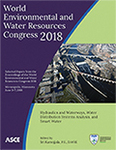World Environmental and Water Resources Congress 2018
Modeling Soil Loss by Water Infiltration through Sewer Pipe Defects
Publication: World Environmental and Water Resources Congress 2018: Hydraulics and Waterways, Water Distribution Systems Analysis, and Smart Water
ABSTRACT
Due to deterioration of sewer pipes, soils can be lost by water infiltration through pipe defects, which may result in ground collapses and/or the formation of urban sinkholes. In this paper, soil particles without cohesion are simulated using a coupled discrete element method, and the Darcy’s water model is incorporated to account for the soil/water interaction. The parameters in this numerical model are calibrated using previous physical experimental measurements. From the numerical results, soils above the pipe defect will be washed out by water flow in a narrow zone just above the pipe defect, and the width is proportional to the pipe defect size. Based on the analysis of the force chain between soil particles in the erosion process, it is found that soil particles close to the pipe defect are lost under the gravity and drag force, whereas the friction between soil particles has a negligible effect on the soil particle motion. From the variation of soil flow rate in the erosion process, the rate of soil loss is proportional to the water flow rate in the erosion process. An analytical model is developed incorporating Stokes law to account for the water flow, and the model is verified by comparing with physical and numerical results. The mechanism of soil loss due to defective sewer pipe is investigated in this numerical simulation, and the proposed analytical model provides an effective approach for estimating the soil flow rate in the erosion.
Get full access to this chapter
View all available purchase options and get full access to this chapter.
ACKNOWLEDGEMENT
This research is supported by Alberta Innovation Technology Futures (AITF) Graduate Student Scholarship, Mitacs Globalink Research Award, and China Scholarship Council (CSC). The authors also acknowledge the financial support from the Natural Sciences and Engineering Research Council of Canada (NSERC).
References
Chan, D. (1993). "Numerical simulation of wet granular flow." The International Conference on Soft Soil Engineering, Guangzhou, China, 68–73.
Cundall, P. A., and Strack, O. D. L. (1979). "A discrete numerical model for granular assemblies." Geotechnique, 29(1), 47–65.
Freeze, R. A., and Cherry, J. A. (1979). Groundwater, Prentice-Hall, Englewood Cliffs, New Jersey.
Goodarzi, M., Kwok, C. Y., and Tham, L. G. (2015). "A continuum-discrete model using Darcy's law: formulation and verification." International Journal for Numerical and Analytical Methods in Geomechanics, 39(3), 327–342.
Guo, S., Shao, Y., Zhang, T., Zhu, D. Z., and Zhang, Y. (2013a). "Physical modeling on sand erosion around defective sewer pipes under the influence of groundwater." Journal of Hydraulic Engineering, 139(12), 1247–1257.
Hakuno, M., and Tarumi, Y. (1988). "A granular assembly simulation for the seismic liquefaction of sand." Proceedings of the Japan Society of Civil Engineers (398), 129–138.
Hilton, J., and Cleary, P. (2011). "Granular flow during hopper discharge." Physical Review E, 84(1), 011307.
Indiketiya, S. H., Jegatheesan, P., and Rajeev, P. (2017). "Evaluation of defective sewer pipe induced internal erosion and associated ground deformation using laboratory model test." Canadian Geotechnical Journal.
Mukunoki, T., Kumano, N., Otani, J., and Kuwano, R. (2009). "Visualization of three dimensional failure in sand due to water inflow and soil drainage from defective underground pipe using X-ray CT." Soils and Foundations, 49(6), 959–968.
Rushton, K. R., and Redshaw, S. C. (1979). Seepage and groundwater flow: numerical analysis by analog and digital methods, Wiley.
Sato, M., and Kuwano, R. (2015). "Influence of location of subsurface structures on development of underground cavities induced by internal erosion." Soils and Foundations, 55(4), 829–840.
Tang, Y., Zhu, D. Z., and Chan, D. H. (2017a). "Experimental Study on Submerged Sand Erosion through a Slot on a Defective Pipe." Journal of Hydraulic Engineering, 143(9).
Tang, Y., Chan, D. H., and Zhu, D. Z. (2017b). "A coupled discrete element model for the simulation of soil and water flow through an orifice." International Journal for Numerical and Analytical Methods in Geomechanics, 41(14), 1477–1493.
Taylor, D. W. (1948). Fundamentals of soil mechanics, Wiley, New York.
Thallak, S., Rothenburg, L., and Dusseault, M. (1990). "Hydraulic fracture (parting) simulation in granular assemblies using the discrete element method." AOSTRA Journal of Research, 6, 141–153.
Information & Authors
Information
Published In
World Environmental and Water Resources Congress 2018: Hydraulics and Waterways, Water Distribution Systems Analysis, and Smart Water
Pages: 254 - 262
Editor: Sri Kamojjala, Las Vegas Valley Water District
ISBN (Online): 978-0-7844-8142-4
Copyright
© 2018 American Society of Civil Engineers.
History
Published online: May 31, 2018
Authors
Metrics & Citations
Metrics
Citations
Download citation
If you have the appropriate software installed, you can download article citation data to the citation manager of your choice. Simply select your manager software from the list below and click Download.
